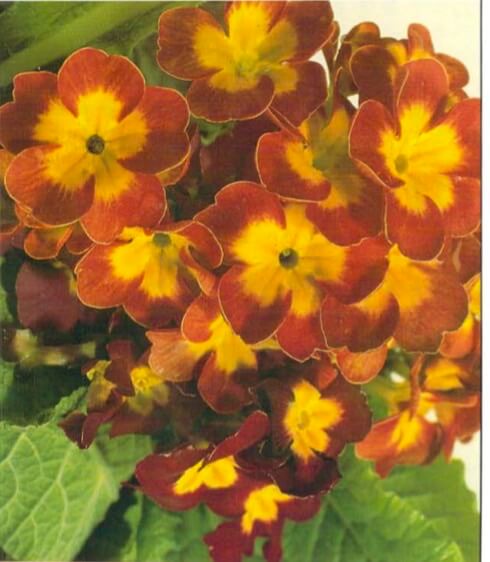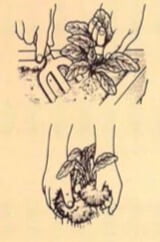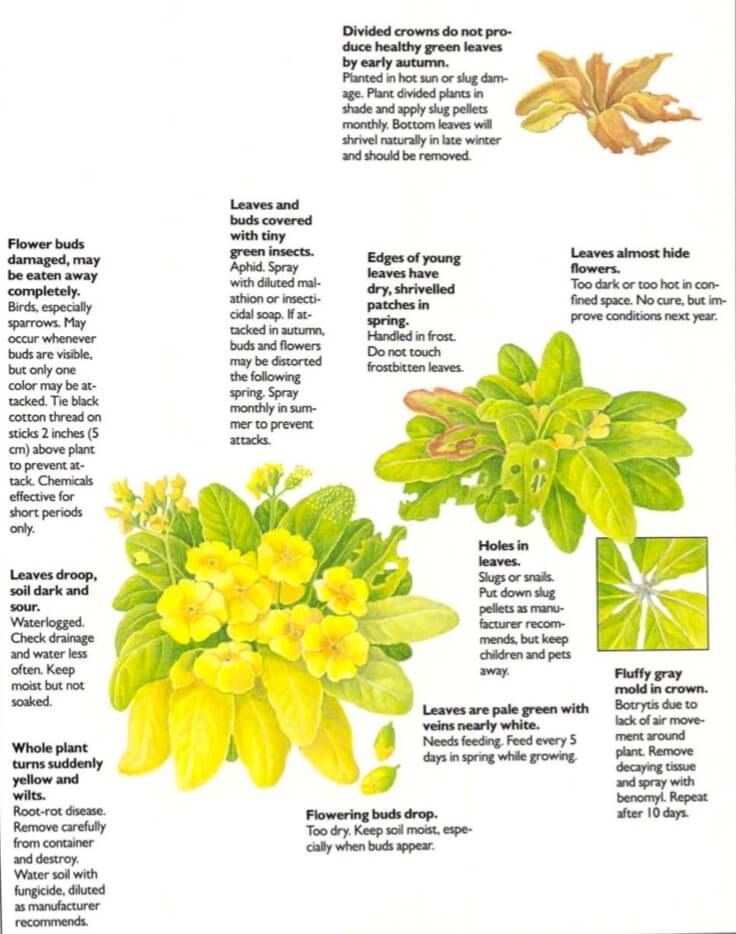[Ebook Việt Hoá] The Instant Guide to Healthy Houseplants (Hướng dẫn tức thời để chăm cây trong nhà khoẻ mạnh), Chi Primula - Chi Anh Thảo
[Ebook Việt Hoá] The Instant Guide to Healthy Houseplants: Primula elatior (Polyanthus primrose, Oxlip)
- Nguồn: [Ebook Việt Hoá] The Instant Guide to Healthy Houseplants (Hướng dẫn tức thời để chăm cây trong nhà khoẻ mạnh)
- Biên tập: Dũng Cá Xinh
- Biên dịch: Team Codai.net
English
Polyanthus and primroses are well known signs of spring. Though their flowering season is short, they are well worth an early place in boxes and tubs. They like a moist, cool soil and a refreshing spray of water on their leaves when hot. Refrain from buying plants in flower in spring, as they are difficult to establish. Instead, sow seeds in late spring. The true primrose (Primula acaulis) is of the same family as the polyanthus and should be treated the same.

Light
Needs maximum light in spring and 40 percent shade in mid-summer, when plants are resting or establishing themselves in a new place.
Temperature
Not above 55°F (13°C). Will tolerate frost.
Water
Needs cool, moist soil. Flower buds drop off if soil is too dry before flowering.
Humidity
Spray leaves in hot weather to help cool plant.
Soil
Use loam or. better still. soilless potting mix.
Feeding
After flowering, fertilize with bonemeal, dried blood or fishmeal as manufacturer recommends. Do not feed from early autumn to late winter, then feed with fertilizer diluted to manufacturer’s recommended strength every 5 days until in full flower.
Propagation
Sow in late spring or early summer. Prepare seed tray and sow very thinly. Cover with 1/2 inch (2 mm) moist soil. seal in plastic bag and keep in cool (45°F – 7°C), sunless place until germination (10-20 days). Soil should stay moist without watering. When large enough to handle. prick out seedlings into small pots or 2 inches (5 cm) apart in trays. Or divide existing plants after flowering.
Maintenance
Cut off dead flowers. Remove dead leaves at the end of winter.
Varieties
Hardy: Giant Bouquet, Kelscott, Giant Yellow. Almost hardy: Pacific hybrids.
Division
- 1. After flowering remove plant carefully from container and shake soil from around roots.
- 2. Gently pull roots and stems apart. Plant in shady part of garden or in pot and keep moist and cool through summer. Plant in permanent location in mid-autumn. Remove dead bottom leaves in spring

What Goes Wrong

- Flower buds damaged, may be eaten away completely: Birds, especially sparrows. May occur whenever buds are visible, but only one color may be attacked.Tie black cotton thread on sticks 2 inches (5 cm) above plant to prevent attack. Chemicals effective for short periods only.
- Leaves droop, soil dark and sour: Waterlogged. Check drainage and water less often. Keep moist but not soaked.
- Whole plant turns suddenly yellow and wilts: Root-rot disease. Remove carefully from container and destroy. Water soil with fungicide, diluted as manufacturer recommend.
- Leaves and buds covered with tiny green insects: Aphid. Spray with diluted malathion or insecticidal soap. If attacked in autumn, buds and flowers may be distorted the following spring. Spray monthly in summer to prevent attacks.
- Edges of young leaves have dry, shrivelled patches in spring: Handled in frost. Do not touch frostbitten leaves.
- Leaves almost hide flowers: Too dark or too hot in confined space. No cure, but im- prove conditions next year.
- Divided crowns do not produce healthy green leaves by early autumn: Planted in hot sun or slug damage. Plant divided plants in shade and apply slug pellets monthly. Bottom leaves will shrivel naturally in late winter and should be removed.
- Flowering buds drop: Too dry. Keep soil moist, especially when buds appear.
- Holes in leaves: Slugs or snails. Put down slug pellets as manufacturer recommends, but keep children and pets away.
- Fluffy gray mold in crown: Botrytis due to lack of air movement around plant. Remove decaying tissue and spray with benomyl. Repeat after 10 days.
- Leaves are pale green with veins nearly white: Needs feeding. Feed every 5 days in spring while growing.
Tiếng Việt
Polyanthus và primroses là những báo hiệu mùa xuân về. Mặc dù mùa ra hoa của chúng ngắn nhưng rất đáng giá khi được đặt trong chậu hoặc khay trồng. Cây ưa loại đất ẩm, mát và phun nước lên lá khi nóng. Không nên mua những cây đang ra hoa vào mùa xuân vì chúng rất khó bền. Thay vào đó, hãy gieo hạt vào cuối mùa xuân. Hoa Anh Thảo (Primula acaulis) cùng họ với chi Anh Thảo và nên được chăm sóc như nhau.

Ánh sáng
Cần ánh sáng tối đa vào mùa xuân và bóng râm 40% vào giữa mùa hè, khi cây đang nghỉ ngơi hoặc tự mọc ở một nơi mới.
Nhiệt độ
Không trên 55 ° F (13 ° C). Cây chịu được sương giá.
Nước
Cần đất ẩm, mát. Nụ hoa sẽ rụng nếu đất quá khô trước khi ra hoa.
Độ ẩm
Phun ẩm cho lá khi trời nắng nóng để giúp cây mát hơn.
Đất
Sử dụng đất mùn hoặc tốt hơn là hỗn hợp không đất.
Bón phân
Sau khi cây ra hoa, bón phân bằng bột xương, huyết khô hoặc đạm cá theo khuyến cáo của nhà sản xuất. Không bón phân từ đầu mùa thu đến cuối mùa đông, sau đó sử dụng phân pha loãng theo khuyến cáo của nhà sản xuất 5 ngày một lần cho đến khi ra hoa rộ.
Nhân giống
Gieo vào cuối mùa xuân hoặc đầu mùa hè. Chuẩn bị khay gieo hạt và gieo thật mỏng. Phủ 1/2 inch (2 mm) đất ẩm. Đậy kín trong túi ni lông và để trong mát (45 ° F – 7 ° C), nơi không có ánh nắng mặt trời cho đến khi hạt nảy mầm (10 – 20 ngày). Đất nên giữ ẩm mà không cần tưới nước. Khi đủ lớn để xử lý, giâm cây con vào các chậu nhỏ hoặc khay cách nhau 2 inch (5 cm). Hoặc chia cây hiện có sau khi ra hoa.
Duy trì
Cắt bỏ những bông hoa đã tàn. Loại bỏ lá chết vào cuối mùa đông.
Các loài
Cây cứng cáp: Giant Bouquet, Kelscott, Giant Yellow.
Cây cứng cáp hoàn toàn: Pacific hybrids.
Chia nhánh
- 1. Sau khi cây ra hoa, cẩn thận loại bỏ cây ra khỏi chậu và lắc đất xung quanh rễ.
- 2. Nhẹ nhàng kéo rễ và thân cây ra xa nhau. Trồng nơi râm mát của khu vườn hoặc trong chậu và giữ ẩm và mát mẻ qua mùa hè. Trồng ở vị trí cố định vào giữa mùa thu. Loại bỏ các lá chết phía dưới vào mùa xuân.

Những vấn đề có thể xảy ra

- Nụ hoa bị hỏng, có thể bị ăn hoàn toàn: Các loài chim, đặc biệt là chim sẻ. Có thể xuất hiện bất cứ khi nào thấy chồi, nhưng chỉ có một màu có thể bị tấn công. Buộc sợi bông đen trên que 2 inch (5 cm) phía trên cây để ngăn chặn sự tấn công. Hóa chất chỉ có hiệu quả trong thời gian ngắn.
- Lá rũ xuống, đất chua sẫm màu: Bị úng nước. Kiểm tra hệ thống thoát nước và tưới ít nước hơn thường xuyên. Giữ ẩm nhưng không ngâm nước.
- Toàn bộ cây đột ngột chuyển sang màu vàng và héo: Bệnh thối rễ. Loại bỏ cẩn thận khỏi chậu và tiêu hủy. Tưới đất bằng thuốc diệt nấm, pha loãng theo khuyến cáo của nhà sản xuất.
- Lá và chồi bị bao phủ bởi côn trùng nhỏ màu xanh lá cây: Rệp. Phun malathion pha loãng hoặc xà phòng diệt côn trùng. Nếu bị tấn công vào mùa thu, nụ và hoa có thể bị biến dạng vào mùa xuân năm sau. Phun hàng tháng vào mùa hè để ngăn chặn sự tấn công.
- Các mép lá non có các mảng khô, teo vào mùa xuân: Bị sương giá. Không chạm vào lá cóng.
- Lá gần che hết hoa: Quá tối hoặc quá nóng trong không gian hạn chế. Không có cách chữa trị, nhưng cải thiện tình trạng trong năm tới.
- Những tán hóa không ra lá xanh khỏe vào đầu mùa thu: Trồng nơi nắng nóng hoặc sên gây hại. Trồng cây trong bóng râm một phần và dùng viên nén diệt sên hàng tháng. Các lá phía dưới sẽ tự nhiên teo lại vào cuối mùa đông và cần được loại bỏ.
- Chồi hoa rụng: Quá khô. Giữ ẩm cho đất, đặc biệt là khi cây ra nụ.
- Lỗ trên lá: Sên hoặc ốc. Đặt viên sên như nhà sản xuất khuyến cáo, nhưng để trẻ em và vật nuôi tránh xa.
- Mốc màu xám trên thân cây: Bệnh đốm đen do thiếu không khí di chuyển xung quanh cây. Loại bỏ mô thối rữa và phun bằng benomyl. Lặp lại sau 10 ngày.
- Lá màu xanh lục nhạt, gân lá gần trắng: Cần bón phân. Cứ 5 ngày một lần bón phân vào mùa xuân khi cây đang phát triển.
![[Ebook Việt Hoá] The Instant Guide to Healthy Houseplants: Primula elatior (Polyanthus primrose, Oxlip) [Ebook Việt Hoá] The Instant Guide to Healthy Houseplants: Primula elatior (Polyanthus primrose, Oxlip)](https://vn1.vdrive.vn/codai.net/2020/02/ebook-huong-dan-tuc-thoi-cham-cay-trong-nha-khoe-manh-133-primula-elatior.jpg)


